Multi grain and seed bread is as delicious as it is healthy. Developed over several years in my home kitchen, it provides fibers, whole nuts and seeds and some full grains as well. The absence of commercial whole wheat bread supply in many parts of Asia was the main stimulus to create this recipe.
The art of making multi grain and seed bread
Ingredients for this multi grain and seed bread are often available locally or in international stores with imported products. Sometimes cracked rye is not available. If there is no cracked rye, either use full rye kernels that have been soaked in water for 2 hrs or substitute by whole grain (dark) rye flour. But the hard winter wheat white flour is pretty essential to create a sufficiently risen (airy) bread. As a substitute, use all purpose flour to which sufficient gluten are added (see remarks).
We bake the bread in loaf pans, to increase the production in the home oven. In most home ovens 3 loafs can be baked. But on a baking sheet we obtain a more crusted bread. However, then maximum two breads can be produced in the home oven.
After the bake and cooling down, it is sliced and frozen in re-sealable bags.
We have consumed this bread daily for over 15 years.
Special equipment
- loaf pan (1 ft x 5 inch; 30 cm x 12.7 cm) or baking sheet
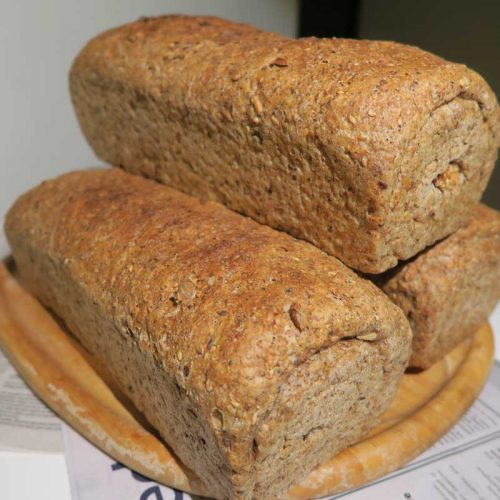
Multi grain and seed bread
For 3 loafs, triple the amounts.
Ingredients
Ingredients for making the pre-ferment
- 8.82 oz (250 g) strong whole wheat flour (protein content 15.8 %)
- 1.23 oz (35 g) stone ground, dark rye flour
- 1.23 oz (35 g) cracked rye
- 0.35 oz (10 g) rolled oats
- 1.76 oz (50 g) crushed buckwheat
- 1.41 oz (40 g) spelt (whole grains)
- 0.26 oz (7.5 g) salt
- 0.06 oz (1.7 g) dried baker's yeast
- 1 cup + 12.7 tbsp (425 g) luke warm (purified) water
Ingredients for making the full dough
- all the preferment (see above)
- 10.6 oz (300 g) very strong white bread flour (protein content 14.9 %)
- 1.06 oz (30 g) flaxseed meal (ground flaxseeds)
- 1.76 oz (50 g) white or yellow sesame seeds
- 1.41 oz (40 g) pumpkin seeds
- 2.82 oz (80 g) sunflower seeds (unflavored for baking)
- 0.56 oz (16 g or 20 ml) vegetable oil (olive or sunflower oil)
Ingredients for the full loaf
- 2.11 oz (60 g) peeled walnuts
- 0.28 oz (9 g or 10 ml) vegetable oil
Instructions
Instructions for making the pre-ferment
- For the preferment, mix the solid ingredients in a large enough bowl, then add the water and continue to mix until the mixture is a very, very thick porridge. Use more water if so needed. Make sure all the ingredients have been fully wetted.
- Let it ferment at room temperature (preferably 25C) covered with plastic wrap or covered by a plate until it is very bubbly (1.5 -2 h).
Instructions for making the full dough
- While the pre-ferment is rising, toast the sesame seeds in a skillet, tossing and mixing until they are two shades darker (3-5 min). Let them cool.
- Mix all the dry ingredients including the cooled sesame seeds, except for the vegetable oil and the pre-ferment
- Place this flour-seed mixture on the clean counter.
- Add the preferment when done and start to mix with the spatula and then knead (I always do this by hand). The kneading best be done by cross folding, stretching and ball rolling. (picture shows the pre-ferment just poured over the dry white flour-seed mixture on the counter)
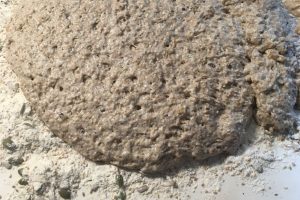
- After 10 minutes of kneading add some white flour if the dough is too wet or add a little bit of water when the mixture would be too dry. I work with a fairly high moisture content, such that the doughball will stick to the counter but not separate or fall apart when rolling over the counter. Continue kneading, stretching and pounding for 10 min more. Then roll into a ball.
- Eventually place the final dough ball in a big enough pan and roll it through 20 ml vegetable oil. Let this ferment in the pan at 25-30 C with the lid on. It is recommended to de-gas one time during the fermentation (after some 1 ½ - 2 h) by pressing down on the dough ball and turning it around and pressing again. Total fermentation time 3-4 h, at lower temperatures longer.
Instructions for making and baking the loaf
- When the dough has fermented sufficiently (after 3-4 h at 25-30 C), roll the dough in a rectangle with a dough roller. Completely de-gas the dough in this step. When the sides are un-even, fold them back in and roll over it, so the width of the dough sheet will have the length of the loaf pan (1 feet) (picture shows loaf pan perpendicular to the dough sheet, with one side of the dough sheet folded back in)

- Do this folding and rolling for each side (picture shows loaf pan perpendicular to the dough sheet, with both sides of the dough sheet folded back in; left the dough pin).
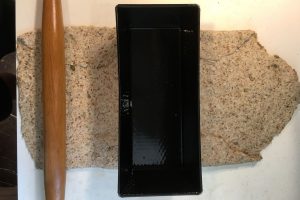
- Then spread the wall nuts out over the dough and roll it tight towards you, using the spatula to separate the dough from the counter. Make sure to flatten the sides of the dough 'cylinder' and place it in the oiled loaf pan. (picture shows rolled dough cylinder just placed in loaf pan, before the final rise)
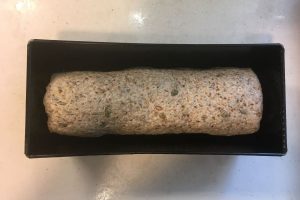
- Let it rise for another 1-1.5 h covered by plastic wrap, until the size has roughly doubled again. This is essential as when the loaf is baked too early, more oven spring may occur, the dough surface may tear, which makes it more difficult to cut the loaf. (picture shows the risen dough cylinder after 1.5 h)

- Pre-heat the oven to 230 C and just before placing the loaf pan in the oven set the thermostat to 180 C. [Thus the initial temperature the loaf is exposed to is 230 C, but the first several minutes there will be no heating coils on, so the oven spring can take place undisturbed]. (Picture shows 3 risen loafs just before placement in oven; the recipe was tripled).
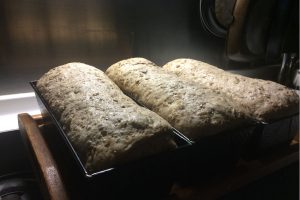
- Place the loaf in the middle of the oven, immediately adding some steam or hot water to the oven and bake for 1 h with the thermostat at 180 C.
- After 1 h take the loaf pan out of the oven using mits and release the bread. Usually shaking the loaf pan keeping it in horizontal position will release the bread from the pan.
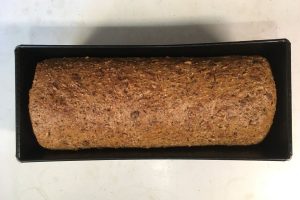
- Let the bread cool down uncovered for more than 1 h before slicing. Then slice the bread to the extent is needed for the meal.

- Optionally freeze the fully sliced bread and take out over time what you need. Frozen bread can be revitalized in a toaster or in a pan with a lid.
Notes
Remarks
- The protein content on the package indicates the gluten content. Aim in this recipe for 14.5-15% proteins in the white bread flour. See also Cooking hints, bread, noodles,dough and batter to understand how to increase the protein content of your white (bread) flour.



